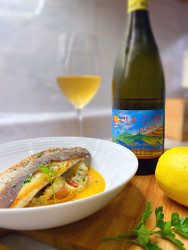Reverse Pairing
Posted by Stephan Lublin on August 16 2020 3:59pm
Wine pairing - In most cases, whether at home or in a restaurant, we choose a wine to accompany our meal - an, “I’ll eat this, so I’ll drink that,” kind of scenario. But for that special bottle, or for those wine-first kinda people, myself included more often than not, it’s more fun and beneficial to do the opposite, choosing your wine first and food to match. When you get it right, an otherwise good meal becomes divine, as both food and wine are elevated to new heights, and the interplay between the two harmonize into one angelic tone. Tonight’s wine is special, from a region I love, the Roussillon, and from a winemaker who’s wines I’ve been longing to try, Bruno Duchene.
In a past life, Bruno was a wild mushroom salesman in the Loire Valley. In 2000 he came down to the Roussillon, fell in love, bought vines in 2002, and never looked back. He farms roughly four hectares of vines, making only a few cuvées of reds, whites, and a rose. The wines mostly fall into the AOC Collioure, and the remaining labeled as Vin de Pays and Vin de France.
Just as Bruno is a fish out of water to the Roussillon, the Roussillon is that to the rest of France. The people here are Catalan, rather than French or Occitan, as the region borders Spain. Here, there are more sunny days than anywhere else in France, but don’t think for a second that his move from the Loire Valley has made his life easier. In the rugged terrain of the Roussillon, rough, rocky hills and terraced vineyards can make things unworkable by machine or even horse driven plow. The vineyard for Bruno’s cuvée l’Anodine is so steep and pitted that all work must be done by hand, aside from a small parcel that can be tilled and plowed with the help of a horse. The manual labor doesn't stop there, as all replantings of vines, Bruno does himself. Organic agriculture is practiced in vineyards, fermentation is spontaneous by indigenous yeast, and no S02 is used.
For this special dinner I decided on the 2019 La Luna Blanc. Made up of 60% Xarel-lo, 30% Vermentino, and the remaining 10%, Chardonnay, it’s clear to see the region’s Spanish influence. This steered my pairing to incorporate Spanish flavors, creating a menu of Pan-Seared Mediterranean Sea Bass with Crushed potatoes and Chorizo Cream Sauce. The wine perfumes fresh citrus, white flowers, golden apple, and a mist of pineapple, and carries a medium to medium plus body, spice, crisp acidity, and even a hint of tannins to the palate. Paired with the meal, the wine’s acidity cleanses the rich sauce from the tongue, and bounces its spice off smoky paprika notes, a true Spanish/French mingling, and successful reverse pairing. The only question remaining is what wine to enjoy tomorrow evening and what dish to pair with it. Salut!


